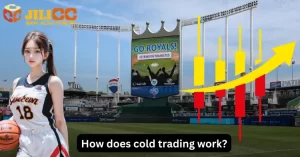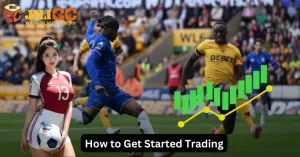Sports trading has traditionally been the domain of people with deep insights into teams, athletes, and game dynamics.
However, a relatively modern newer concept known as Cold Sports Trading provides yet another dimension to how people without extensive knowledge of sport can engage in a bet or trading market. Unlike the traditional method, which depends on personal judgments, cold trading lacks emotional and analytical prejudice. Hence, it is the market pattern, odds movements, and statistic-based.
Here, Jilicc will describe what cold trading is, how it works, and how you can profit from it even without being a sports expert.
What is Cold Sports Trading?
Cold sports trading means an emotionless, data-driven way of conducting a bet based on market behavior and not precisely on real knowledge or predictions over the events involved. The term is loaned from financial markets, where cold trading is common, reaping many benefits by excluding emotional attachment from making the final decisions.
In sports betting, this very same thing happens when you capitalize on changing odds or movements of the market and not the outcomes of a certain event.
Unlike traditional betting, where you might back a team or player because you think that is going to win, cold trading focuses purely on the patterns of the market. Concretely, what traders observe is the changing pattern of odds over time and will look to buy low and sell high, irrespective of the game’s outcome.
How does cold trading work?

Cold sports trading takes place on a betting exchange and not with a traditional bookmaker. With the betting exchange, users are given the possibility to back and lay outcomes, offering more opportunities, such as trading your position in much the same way you would in the stock markets. Some of the basic, grassroots principles involved with cold trading include:
Market Monitoring
Cold traders invest time in monitoring the changes of odds within live markets rather than analyzing the game or match itself. In other words, the idea is to find those opportunities where the odds are too high or too low based on the fluctuation in the market, not the actual probability of a certain team’s win.
Backing and Laying
Cold traders make two types of bets in sports trading exchanges.
- Backing a team or outcome to win.
- To lay a team or outcome to lose.
The aim is to be able to buy low back when the odds are high and sell high-lay when the odds shorten to lock in a profit regardless of the final outcome.
Arbitrage and Hedging
Cold traders often employ techniques such as arbitrage or hedging in order to ensure gains. Arbitrage is a technique whereby you bet on all possible outcomes in such a way that whatever the outcome, you will gain. Hedging is a technique of cutting losses by trading out a bet when the odds are in your favor.
Ignoring Game Context
Unlike traditional betting, cold traders do not need to know about team form, player injuries, or the state of the various fields and weather conditions a match may be subjected to. Rather, they concern themselves with how the market is moving. In doing so, they are able to make decisions unclouded by emotional factors or fan biases.
Benefits of Cold Sport Trading
Cold sports trading has a number of advantages, especially for people who do not follow sports but are interested in betting or trading opportunities.
No Prior Knowledge of Sports Required
Another of the strong points of trading in cold conditions is that it needs no deep understanding of the sport. Since all the decisions are related to market movements and not predictions over the game, even those who don’t show much interest in sports can come up very effectively. All you need is an understanding of how odds and betting exchanges work.
Less Emotional Bias
Cold traders rely on statistics and the movements of odds while always avoiding using feelings or personal sympathies with any team or player. This removes the very common error-putting a bet with your heart, not your head.
More Profit Making Opportunities
Since cold traders do not invest in the outcome of a match, they can perform a variety of trades during the event. You can make money through the movement of odds without prediction over the winner. You can take an early cash-out and lock in any profit made as long as the odds go in your favor, regardless of the eventual outcome.
Less Time Consuming
Cold trading involves monitoring the markets, not the teams or players and can be less time-consuming because of this factor for those interested in getting involved in sports trading without having the time to keep up-to-date on every development in sports.
Potential Dangers of Cold Sports Trading
Cold sports trading, just like every other trading strategy, involves some risks and requires caution while attempting an approach toward it.
Sudden Market Swings
The risk in cold trading is that some events in a game, such as a red card or an important player being injured may cause a sudden change in odds. Cold trading depends on market motion, and its unexpected changes may cause fatal losses if bad events are not properly treated.
Liquidity Problems
In most cases, smaller markets or less favorite sports do not have enough liquidity to enable profitable trades. Low liquidity might affect the purchasing or selling of a position by possibly trapping traders in losing bets or refusing them an opportunity to cash out on the profitable ones.
Need for Fast Reactions
Cold trading involves keen eyes toward the market, and changes must be reacted to in very short order. Odds change within a matter of seconds, and a trader should be attentive enough to make strong decisions without delay; likewise, the market could go the other way in just that quick an amount of time.
Cold Sports: How to Get Started Trading

If cold trading seems exciting to you, here are a few tips that’ll help get you started:
Start Small
First, start by trading with small stakes to get yourself initiated with how cold trading actually works. You do not want to put too much of your capital into it early in the game as you are still trying to learn how the market moves.
Betting Exchanges
Concentrate on the exchanges that provide betting exchanges, for example Betfair and Smarkets. Both exchanges will give you the opportunity to back and also lay bets, therefore affording you a wide latitude to trade in and out of markets.
Analyze Market Data
Instead of researching teams or players, the focus should fall on the analysis of historical odds data. Many tools and platforms offer insights into how the odds have moved over time, enabling you to identify trends and opportunities.
Be Disciplined
Cold trading demands discipline and patience. It requires no follow-up of losses and impulsive altering strategies on account of short-term movements in the market. Concentrate on the bottom line and think about the big picture.
>> Read more:
Summary
Cold sports trading makes it possible for any person to participate in a betting market, even if they have little or no knowledge about sports. With this kind of trading, traders can easily benefit from the movement of odds without necessarily needing to be a sports expert.
While this kind of trading is highly risky, just like any other kind of trading, cold trading offers an emotion-free and data-driven approach to sports betting, opening more avenues for more participants.
Cold trading might be the best possible way to enter the exciting world of sports betting if there are any people who ever prefer logic and statistics over emotions and instincts.



Fantastic beat ! I wish to apprentice while you amend your site, how could i subscribe for a blog web site? The account helped me a acceptable deal. I had been tiny bit acquainted of this your broadcast offered bright clear idea